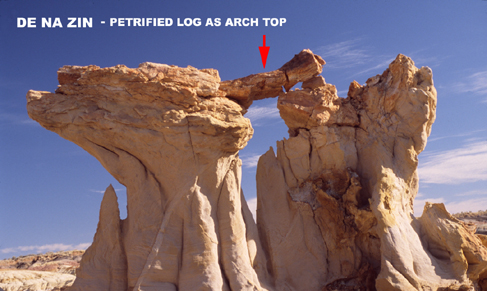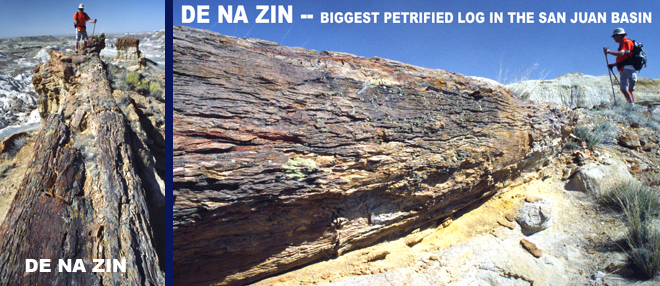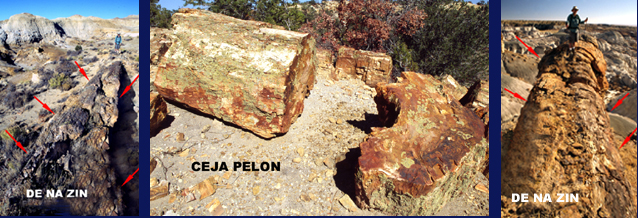
BADLANDS TREASURE TROVES :
FOSSILS AND PETRIFIED WOOD
link to Petrified Wood photo tour

SAN JUAN BASIN FOSSIL RECORD
The fossil record in the San Juan Basin is long and detailed, spanning a total of almost 200 million years beginning about 230 million years ago and continuing up till about 38 million years ago. Several unconformities (time gaps) in the layer succession yield a few missing chapters in the fossil record.
Even so the story is long, action packed, and quite varied. Rich San Juan Basin fossil treasure troves include everything from deepwater marine invertebrates, to fish, crocodiles, numerous dinosaurs--some like the Seismosaurus and Pentaceratops unique to the basin--, giant flightless birds, early mammals, and extensive forests of petrified wood. This diverse fossil legacy helped spur the initial establishment of the New Mexico Museum of Natural History. Bisti fossil beds alone have produced over 200 different plant and animal species.
For a more detailed look at each badland visit the individual badlands pages. The following, brief paleoecological overview skips several layers rich in fossils
We begin our story 150 million years ago in Ojito Wilderness’s Morrison formation when the area was networked with rivers, streams, and lakes where dinosaurs roamed. Giant suaropod grazers were food for vicious Allosaurus predators. Move forward to Ojito’s Dakota formation 108 million years ago when the area was a shoreline being slowly inundated by an expanding narrow seaway that stretched from Canada south all the way into New Mexico. Marine mollusks and other invertebrates left shells, and fishes left skeletons. Continue forward to Ojito’s Mancos formation about 85 million years ago when the area was completely underwater as shown by large spiraled ammonite shells and sharks teeth.
Now jump forward to the Bisti and Ah Shi Sle Pah badlands in the Fruitland and Kirtland formations starting about 75 million years ago. A final episode of several Cretaceous inland sea incursions was retreating to the north and the area was a lush patch work of river deltas, wetlands, and shallow, brackish lagoons. The last of the dinosaurs roamed through massive cypress-like conifer forests where fresh and salt water fish swam in shoreline bayous and swamps.
Move forward in time to Lybrook, Penistaja, Ceja Pelon, and Mesa De Cuba badlands in the Nacimiento layer about 65 million years ago in the beginning Paleocene. The basin was verdant with forests, freshwater swamps, rivers, streams and bogs. Dinosaurs were long gone but mammal evolution was gaining momentum as shown by early primates, and small hoofed animal fossils. Thick forests left massive petrified wood caches. Finally move to the San Jose badlands in the San Jose Formation at about 54 million years ago in the Eocene, when mammal evolution was accelerating and branching in diversity. Still relatively small, mammals hid from the top predator, a 10 feet tall flightless bird called Diatryma, in richly forested wetland ecosystems that had prevailed for most of the basin's 230 million year history.

PETRIFIED WOOD
Petrified wood is by far the most common fossil you’ll encounter on badlands hikes. Ojito, Bisti, Penistaja, Mesa de Cuba, De Na Zin, and especially Ceja Pelon hold many large, colorful, perfectly preserved logs. The largest I know of is a 50 feet long trunk with a fluted base and root clump 7 feet in diameter which forms the top of a huge hoo doo in De Na Zin. Ceja Pelon sports miles of almost non-stop scattered trunks with large bases and root clumps. Numbering in the hundreds, these logs form the largest petrified wood cache in the southwest outside of Petrified Forest National Park.
San Juan Basin Cretaceous petrified wood comes from large cypress-like conifers that flourished during dinosaur and early mammal times; but prolific Tertiary, Nacimiento deposits also include more modern deciduous “broadleaf” species. Preserved with incredible detail, bark patterns, knotholes, tree rings, trunks, fluted bases, and root clumps can all appear amazingly lifelike. Just as in hoo doo formation, conditions must be ideal for this much high quality petrified wood to form.

HOW PETRIFIED WOOD FORMS
Many big logs must get buried quickly in anaerobic, or lack of oxygen, conditions so decay doesn’t start. The extensive flood plains and swampy environments that prevailed for millions of years in the basin would have been perfect. Mineral rich ground water must then continue supplying ample silicates or calcites to the buried logs for the petrification process to occur, along with trace metal impurities for color. Periodic volcanic ash showers during Tertiary times from the rapidly rising San Juan Mountains just to the north were particularly helpful in supplying extra silicates and trace metals.
The petrification process involves a slow steady replacement of biological structures by crystalline compounds like silica (quartz), and more rarely by calcite (the same material that forms stalactites in caves.) Both these substances are colorless, but metallic trace impurities embedded in the crystal matrix add various colors as follows:
- Copper, Cobalt, & Chromium – green/blue
- Manganese – pink
- Iron Oxides – red, orange, brown
- Carbon & Manganese Oxides – black
- Silica – white, grey
LEAVE FOSSILS IN PLACE FOR COMING GENERATIONS
Sometimes I'm tempted to pick up interesting rocks or fossils, but a moment’s reflection makes it clear that future hikers should also be able to enjoy the badlands. Official BLM rules concerning collecting, allow for a “reasonable amount” of mineral specimens, petrified wood, or invertebrate fossils for “personal use.” However, again, it is both unnecessary and unethical to carry off anything from the badlands to claim as your own. Collecting vertebrate fossils or archaeological antiquities is strictly illegal.
The well known wilderness hiker’s ethic says it all: “Take nothing but pictures and leave nothing but footprints.”

| HOME |
GEOLOGY |
PHOTOGRAPHY TIPS | RECREATION | MAP - INDIVIDUAL BADLANDS |
| INDIVIDUAL BADLANDS PAGE | PHOTO TOURS |
BADLANDS OVERVIEW |
This site is property of PhotoTrekNM. All rights reserved. Copyright 2007.
